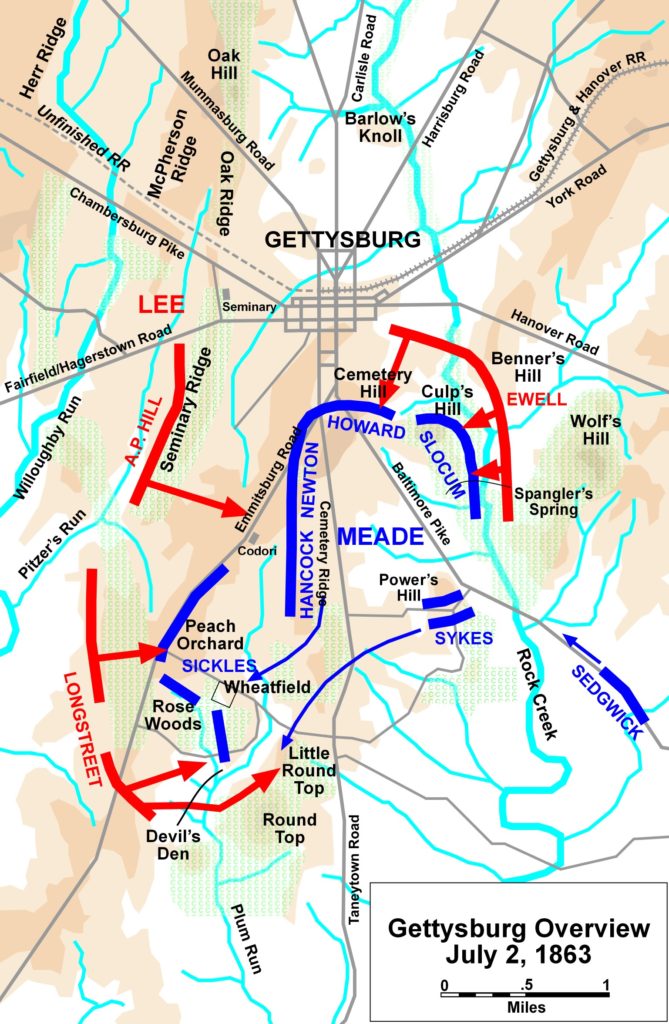After fierce fighting to the west of Gettysburg on day 1, both armies were in place for another conflict on July 2, 1863. The Union held strong defensive positions on the high ground just South of the town of Gettysburg on day 2. Their defenses were in the shape of a "fishhook," and strong interior lines would allow them to reinforce quickly where needed. Their line ran about 3 miles from Culp's Hill, creating the Union right and extending to the Union left the north of Little Round Top.
Jump to:
The prior evening and early that morning, most of both armies had arrived on the battlefield, including the Union II, III, V, VI, and XII Corps. General George Meade arrived close to midnight and asked Hancock about their position. Hancock assured Meade that they were on very good ground.
The Confederates, on the other hand, were spread out over a 5-mile area, and in addition to having to attack uphill, their coordination would have to be perfect. General Robert E. Lee had made the decision to attack the Union positions on their left flank where he felt they were weakest and to display on the Union center to prevent the Union from reinforcing the left. Once the Confederates engaged the left flank, they were to attack the right as well.
Battle of Gettysburg Day 2: Attack on the Union Left
It was decided that General James Longstreet's First Corp would lead the attack on the Union left. A Union signal station on top of Little Round Top forced Longstreet to spend most of the day marching in a wide arc to get in position without being detected. His goal was to get his troops massed on the Union left, then start a massive coordinated attack that would catch the Federals off-guard. The attack was intended to collapse the left flank of the Union Army and roll up the Federal line from west to east along the hills.
At approximately 4 p.m., Longstreet was ready, and the attack of roughly 14,000 Confederates was ordered. Longstreet's division overwhelmed their first resistance in the Peach Orchard, occupied by Union General Daniel Sickles of III Corps. Prior to the battle of Gettysburg Day 2, Sickles was not satisfied with the position Meade ordered him to occupy on the battlefield on the south end of Cemetery Ridge. He instead moved his men a half mile northwest to higher ground, which created a salient in the Union line. Sickles made this decision without consulting with George Meade, and by the time Meade found out, it was too late to order Sickles to redeploy back to his original position.
The salient meant III Corp could be attacked from multiple sides, and Longstreet's division quickly overwhelmed them. They quickly lost enough men that they were ineffective as a fighting force. Sickles' leg was crushed by a cannonball and later amputated. Meade was forced to send close to 20,000 reinforcements to plug the hole or risk a total collapse of the Union left.
There were other consequences to Sickle's deployment of troops on Gettysburg day 2. A strategic position on the Union left flank known as Little Round Top was left undefended. Union Brigadier General Gouverneur K. Warren realized the importance of this position and sought out Union troops to take command of this hill before the Confederates could occupy it themselves.
Colonel Strong Vincent was located by one of Warren's aides, and his brigade was in an ideal position to defend Little Round Top. Without consulting his superiors, Vincent moved his brigade made up of the 140th New York, 16th Michigan, 83rd Pennsylvania, and 20th Maine regiments and stretched them in a thin line across Little Round Top.
The 20th Maine, commanded by Colonel Joshua L. Chamberlain, took up a position at the extreme left flank of the Union Army, and Vincent communicated that Chamberlain must not retreat under any circumstances. Vincent then returned to the right flank of Little Round Top, where the 16th Michigan was losing ground to the advancing Confederates. In an effort to rally his troops, he stood on top of a large boulder and yelled: "Don't give an inch!" Vincent was shot through the thigh and groin and was removed from the battlefield to a nearby farmhouse, where he died 5 days later.
Meanwhile, fighting was fierce on the extreme left flank as the 20th Maine attempted to quell attacks from the 15th Alabama Infantry regiment, under Col. William C. Oates, in attempts to flank the Union position. Nearly out of ammunition, Colonel Chamberlain ordered his men to fix bayonets, and a subsequent charge down the hill forced the Confederates to retreat, and many were captured on Gettysburg day 2.

Battle of Gettysburg Day 2: Attack on the Union Right
Around 5 p.m., Confederate General Ewell began attacking the Union right at Culp's Hill. Union General George Meade had moved XII Corps to reinforce the Union left earlier, leaving only Brigadier General George S. Greene to defend Culp's Hill. Green stretched his lines as thinly as possible behind breastworks on the upper hill and awaited the Confederate infantry assault.
Greene had constructed strong defensive works and relied heavily on them to defend the hill. Ewell commenced the attack with two divisions under Johnson and Stuart, and they were able to flank the Union right and occupy the lower level of Culp's Hill. Strong interior Union lines, however, allowed for quick reinforcements, and XI Corps were able to assist Green in repelling the Confederate attacks.
Had the Confederate attack been better coordinated, they may have succeeded, but with Jubal Early's failure to support his initial attacks and Major General Robert E. Rode's failure to support Early with an attack from the west on Cemetery Hill, Gettysburg day 2 ended with the Union still holding possession of the heights.
